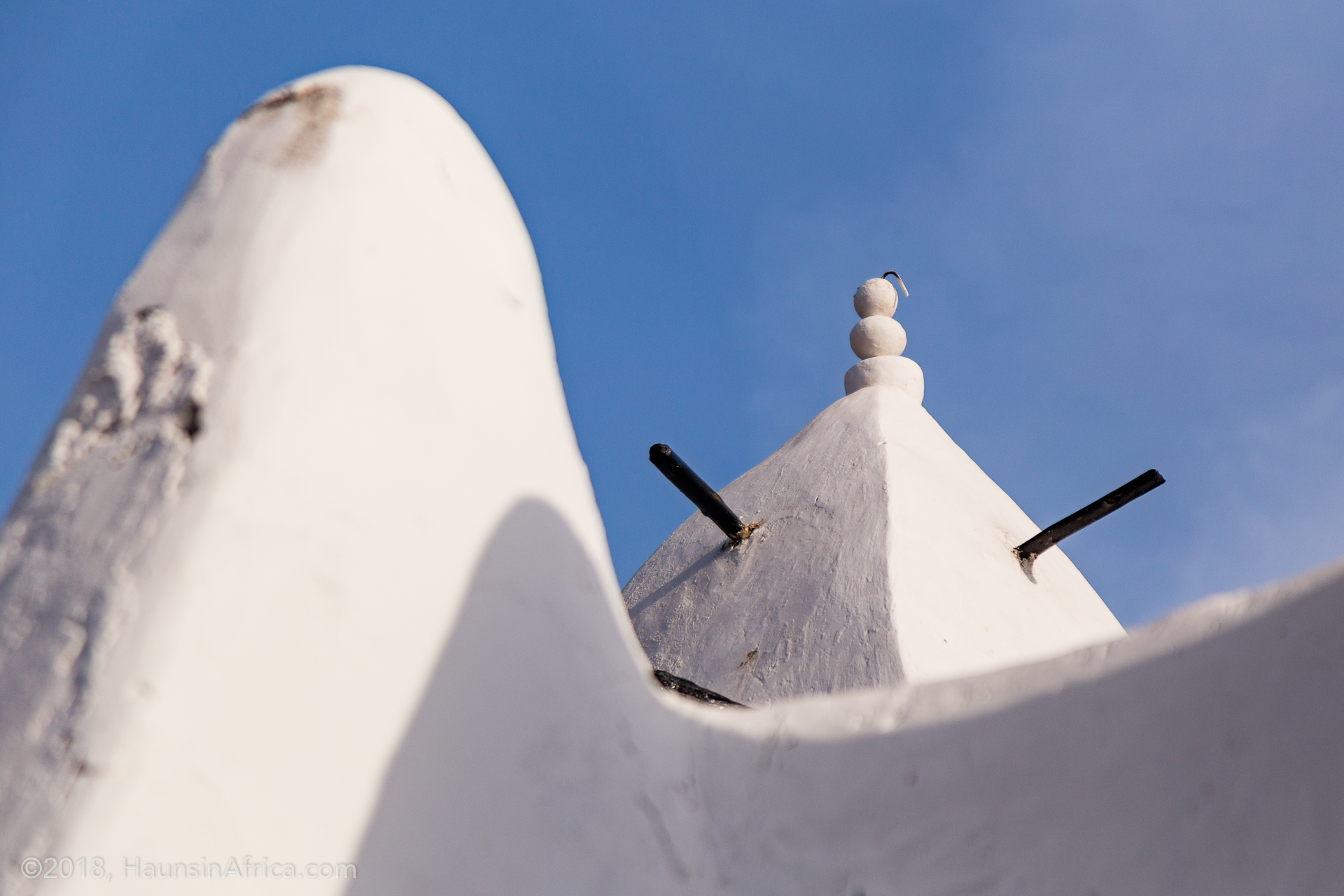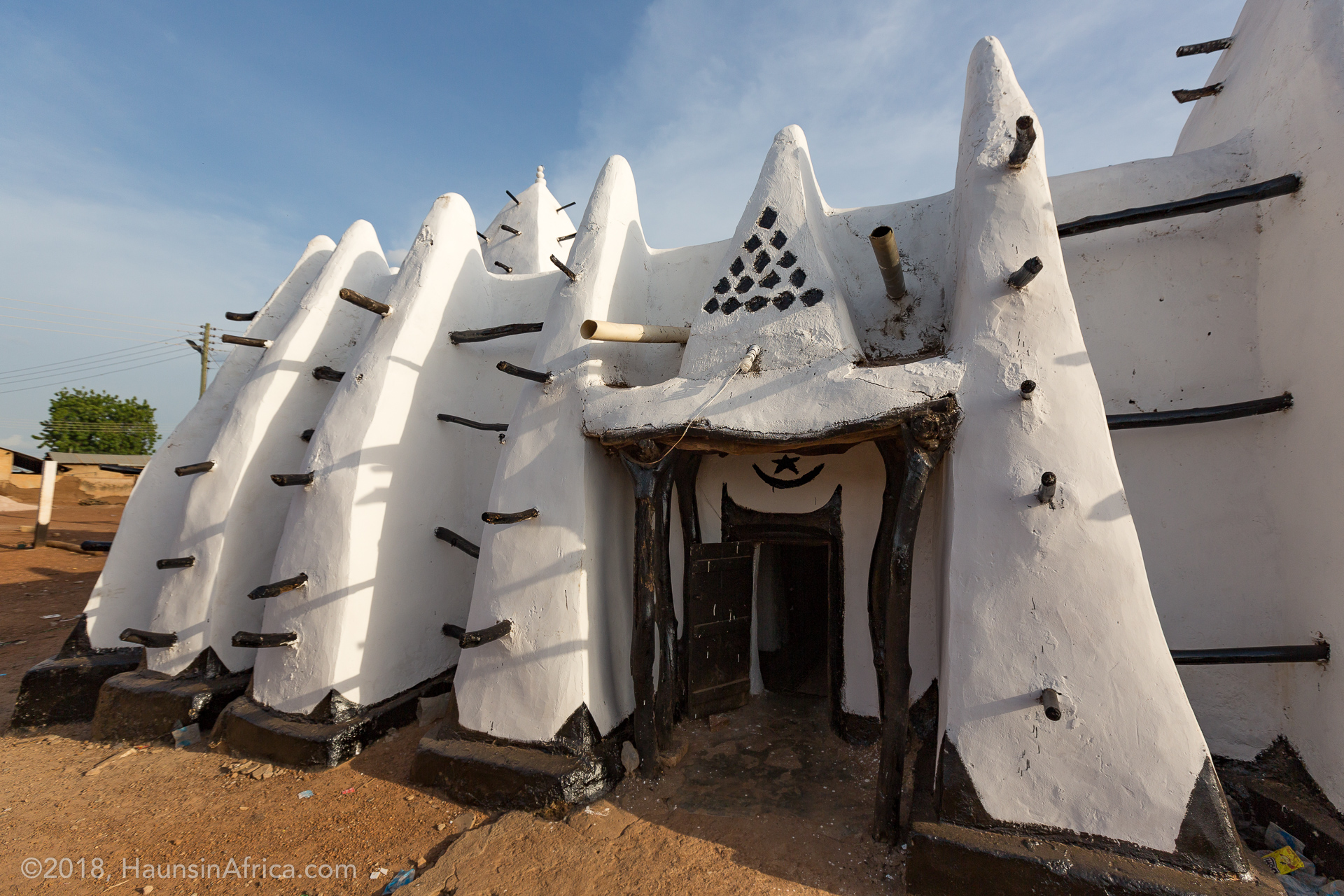This is one of a series of posts about Ghana’s only six remaining historic mud mosques built in the Sudano-Sahelian architectural style.
The history of the mud mosque in Larabanga is difficult to distinguish from the many myths about it. Its fame and popularity probably owe a lot to the appeal of the mystery and magic in those fascinating legends.

The Many Myths of Larabanga Mosque
Oral and some written historical accounts regarding the founding of the community of Larabanga indicate that it was by a man named Ibrahim Braimah. He was a powerful mallam who came to the region in the 17th century with the Malian invaders that established the Gonja Empire in present-day Ghana’s Upper West and Savannah Regions.

You’ll sometimes hear that the Larabanga mosque was founded in 1421 instead of 1600s and the claim that it is the oldest mosque in all of West Africa. This idea comes from another oral account of an Islamic trader named Ayuba had a dream while staying there instructing him to build a mosque. He awoke to find the foundation of the mosque already constructed. The challenge comes where elements from that oral tradition begin to duplicate and/or conflict with the stories surrounding the mallam Braimah.
Legend has it that after the war in the late 1600s, Braimah threw a spear and determined that he would settle wherever it landed. It traveled through the air and landed on a high spot that seemed unnaturally bright. It was there that he built the mosque and his home. He named the community that sprung up around him “Larabanga” meaning “Land of the Arab.”
The next legend is that some indigenous people told Braimah of a nearby site with powerful spiritual properties. He went there and prayed for Allah to give him a Qur’an. Lo and behold, a large Qur’an fell from the sky into his hands. It was one of the seven oldest compiled Qur’ans in the world that resided in Mecca. To this day, they bring it out during the annual Fire Festival to read from it.

Another myth connected to the mosque of Larabanga is that the baobab growing on its western side sprouted from the grave of its founder (was that Ayuba in 1421 or Braimah in 1600s?). The leaves from the tree are believed to have special life-giving powers and are harvested annually and distributed among the four clans in the village. (Note that some baobabs have been proven to be over 1600 years old, so a 15th century tree standing today is very feasible.)
There are other myths involving the defeat of the invader Samori Touré in the late 1800s and in the 1960s a mystic stone that road construction workers had to deviate around. These all boost the credibility of Larabanga as a powerful, spiritual site in northern Ghana both in the past and in contemporary culture.

Saving the Larabanga Mosque
Another factor in Larabanga’s fame is the global attention it received in 2002 after its mihrab and minaret collapsed. In the 1970s, well intentioned but poorly executed conservation efforts plastered the outside of the mosque with cement. This caused moisture to be trapped inside the mud walls and led to wood-rot and termite infestation. A destructive 2002 storm finally revealed the internal damage to the structure. This disaster brought it to the attention of conservationists who had the mosque added to the World Monuments Fund’s 100 Most Endangered Sites list. Funds were donated by American Express, experts in mud-plastering were brought in and the historic mosque was restored.
Convenience Trumps Conservation
Unfortunately, traditional mud plastering has to be re-applied every year. A mere year after the reconstruction, the local community went back to using cement plaster. So to this day, the Larabanga mosque remains an endangered site because the 2002 disaster is wont to happen again. In fact, of all six of the remaining mud mosques in Ghana, only Woriyanga continues the tradition of mud-plastering instead of concrete. Perhaps this is because of the six buildings, it is the most remote and least visited.

Architecture of Larabanga’s Mosque
For all its fame, the design of this mud mosque is not all that unique. It is very similar to the Bole mosque and lacks the distinct style of Woriyanga or the unique features of Banda Nkwanta. In recent years, the community has built a very bland cinder-block building right next to the mud mosque to provide space for the segregated prayer of women. This takes away the visual appeal the historic building had when it stood alone as Nakore mosque enjoys.

Photo courtesy of WMF 2004
Visiting Larabanga’s Mosque
Foreign visitors must register and pay a ten cedi fee to see this famous mosque. Non-muslims are not permitted to enter.
After my tour of the three northernmost regions in which I visited all six remaining mosques, I can say that this was my least favorite. It very much felt like its care takers cared only for my money and not my visit. I can’t blame them, they are inundated with visitors because of their close proximity to Mole National Park – the northern region’s most popular attraction. At the same time, it irked me a bit that they didn’t appreciate the positive attention and financial support the other five mosques would love to have a fraction of.
I should note that even author Philip Briggs of Bradt Guide fame once called Larabanga one of his “least favorite places in Africa.”




The best resource I’ve seen about the Larabanga mosque and its history is Michelle Apotsos’s book “Architecture, Islam, and Identity in West Africa: Lessons from Larabanga.” However, it’s rare and pricey so I recommend her article in the Winter 2016 edition of African Arts entitled “New Meanings and Historical Messages in Larabanga Mosque.” You can download it for free from Academia.edu.
Be sure to check out my other posts about Ghana’s ancient mud mosques: Banda Nkwanta, Nakore, Maluwe, Bole, Wuriyanga
